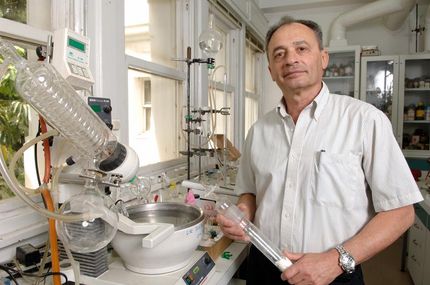Innovative materials and new printing processes driving printed electronics ahead
With nanoparticulate functional materials and innovative printing pro-cesses, researchers from BASF SE, Heidelberger Druckmaschinen AG (Heidelberg) and Darmstadt Technical University are revolutionizing printing technology. Organic electronic products of future potential, such as photovoltaic films or bendable light-emitting diodes, head their list of achievements. As part of the “Forum Organic Electronics” Excellence Cluster sponsored by the German Federal Ministry of education and Research (BMBF), the partners in the NanoPEP project (Nano-structuring & Plastic Electronics Precision Printing Platform) are planning to present the first printed results within three years.
“The electronics of the future are flexible and bendable. It will soon be possible to print low-cost and resource-conserving electronic components with gentle methods on flexible substrates. Utilizing innovative processes and materials on which we are currently working, we are creating a new range of uses for printing technology in Organic Electronics. Working on the modular principle, we can provide numerous modules for cost-efficient mass production,” says BASF Project Leader Prof. Dr. Bernd Sachweh.
Organic Electronics is based on conductive polymers or even smaller molecules from organic chemistry. Its uses range from organic circuits and chips through photovoltaics to organic light emitting diodes. One of the many applications for printed electronics is smart labels that are equipped with sensors. These transponders, which can be printed together with an antenna on films, can be used to measure temperature and atmospheric humidity, an important aspect for the shipment and storage of goods.
Although simple integrated circuits can already be printed today, the challenge lies in producing flexible electronics. For these applications, functional materials – conductive organic molecules – have to be printed in just nanometer-thick, defect-free and very homogeneous layers on top of each other onto flexible plastic or paper substrates. These requirements far exceed those of graphic printing.
“Our long-term objective is to develop printing machines for printed electronics. We are convinced that only printing processes will enable us to meet the cost targets and allow us to manufacture organic electronics at competitive prices for the consumer market,” says Project Leader Dr. Gerd Junghans of Heidelberger Druckmaschinen.
One main focus of research in the Excellence Cluster is the development of hybrid materials consisting of inorganic and organic components. BASF SE is developing new production processes for the manufacture of nanoscale functional materials such as polymer-enhanced zinc oxide. These materials form certain structures or autonomously arrange themselves into shapes and patterns offering new properties for printing technology. Special emphasis is being placed on researching multicomponent systems comprising several materials, as well as integrated processes used to manufacture formulations of materials for Organic Electronics.
With their special properties such as uniform conductivity, nanoparticles are ideal for meeting the high quality standards imposed by Organic Electronics. The nanoparticles used for this purpose are bound in liquids. This technology eliminates direct contact with these materials, ensures their safe handling and allows environmentally friendly production of innovative electronic products.
In a three-stage approach from the laboratory scale to the production environment, experts are optimizing the interplay between materials, application and printing process. Altogether twenty research scientists are involved in the project.
The “Forum Organic Electronics” Excellence Cluster is a cooperative network of three DAX companies, eight international corporations, five medium-sized companies and eleven research institutes and colleges, including two elite universities. The objectives of the Excellence Cluster are to create the world's leading development and production center for Organic Electronics, one of the most attractive places for top-flight researchers and young academics to work as well as the world's leading innovation center for knowledge transfer and company start-ups. The 27 companies, universities and research institutes are cooperating in the research projects for the technology of the future, Organic Electronics, which is being sponsored by the BMBF to the amount of €40 million.
Other news from the department science
These products might interest you
Most read news
More news from our other portals
See the theme worlds for related content
Topic world Sensor technology
Sensor technology has revolutionized the chemical industry by providing accurate, timely and reliable data across a wide range of processes. From monitoring critical parameters in production lines to early detection of potential malfunctions or hazards, sensors are the silent sentinels that ensure quality, efficiency and safety.

Topic world Sensor technology
Sensor technology has revolutionized the chemical industry by providing accurate, timely and reliable data across a wide range of processes. From monitoring critical parameters in production lines to early detection of potential malfunctions or hazards, sensors are the silent sentinels that ensure quality, efficiency and safety.
























































